Strategic Management: Blue Ocean Strategy and Case Analysis
VerifiedAdded on 2023/06/14
|22
|5596
|131
Report
AI Summary
This report provides an overview of the Blue Ocean Strategy, a marketing theory focused on creating uncontested market space to gain a competitive advantage. It details the concept behind the strategy, its characteristics, and the importance of value innovation, which involves creating a leap in value for both buyers and the company. The report also explains the Four Action Framework (raise, eliminate, reduce, create) used to reconstruct buyer value elements and create a new value curve. It further discusses the principles of Blue Ocean Strategy and includes a case study of Bloomberg, a financial information provider, to illustrate the successful application of this strategy. The report emphasizes that by focusing on untapped markets and new demand, companies can achieve high growth and make the competition irrelevant, leading to overall cost reduction and increased value for the organization and its customers. Desklib offers a platform to explore such solved assignments and past papers.

Running Head: STRATEGIC MANAGEMENT 1
Strategic Management
Strategic Management
Paraphrase This Document
Need a fresh take? Get an instant paraphrase of this document with our AI Paraphraser
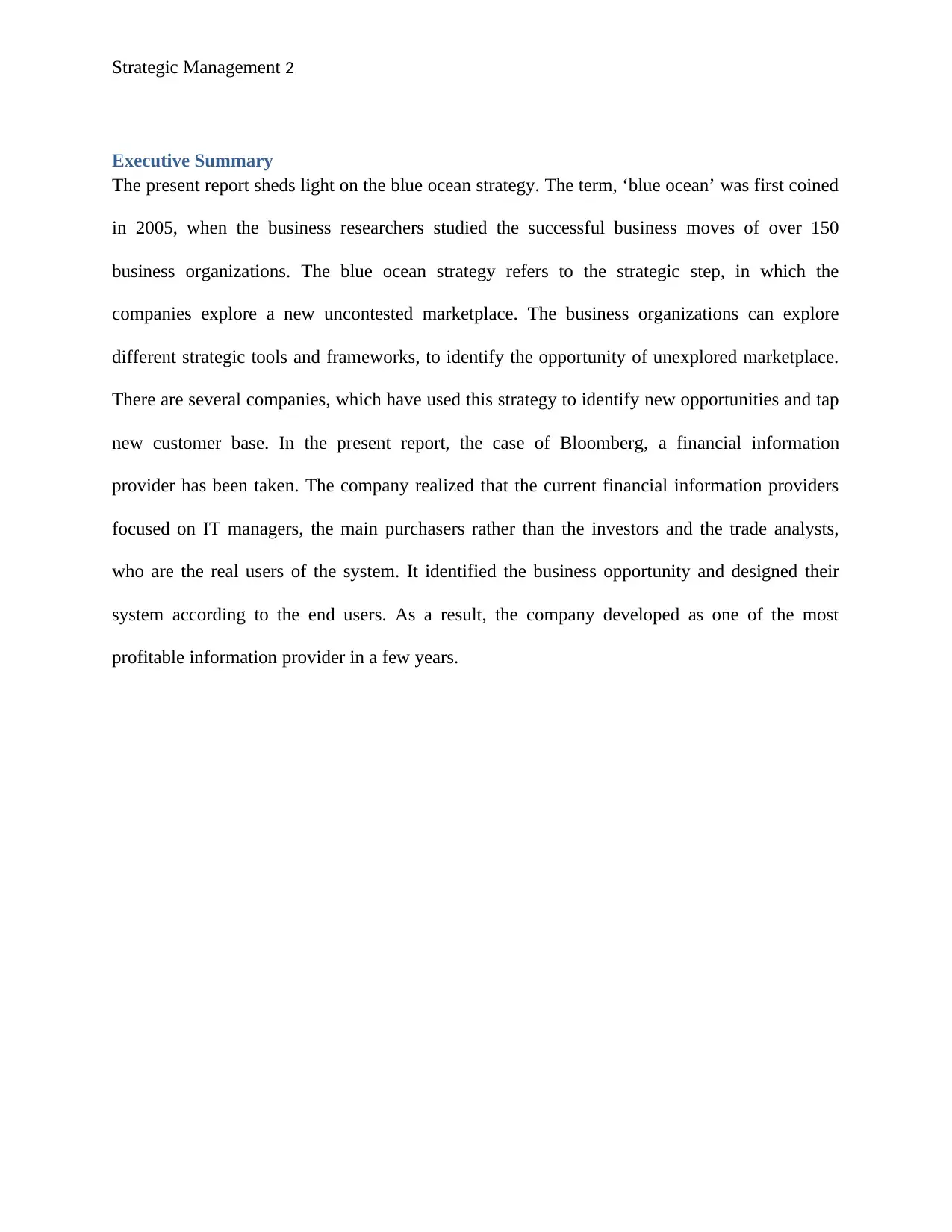
Strategic Management 2
Executive Summary
The present report sheds light on the blue ocean strategy. The term, ‘blue ocean’ was first coined
in 2005, when the business researchers studied the successful business moves of over 150
business organizations. The blue ocean strategy refers to the strategic step, in which the
companies explore a new uncontested marketplace. The business organizations can explore
different strategic tools and frameworks, to identify the opportunity of unexplored marketplace.
There are several companies, which have used this strategy to identify new opportunities and tap
new customer base. In the present report, the case of Bloomberg, a financial information
provider has been taken. The company realized that the current financial information providers
focused on IT managers, the main purchasers rather than the investors and the trade analysts,
who are the real users of the system. It identified the business opportunity and designed their
system according to the end users. As a result, the company developed as one of the most
profitable information provider in a few years.
Executive Summary
The present report sheds light on the blue ocean strategy. The term, ‘blue ocean’ was first coined
in 2005, when the business researchers studied the successful business moves of over 150
business organizations. The blue ocean strategy refers to the strategic step, in which the
companies explore a new uncontested marketplace. The business organizations can explore
different strategic tools and frameworks, to identify the opportunity of unexplored marketplace.
There are several companies, which have used this strategy to identify new opportunities and tap
new customer base. In the present report, the case of Bloomberg, a financial information
provider has been taken. The company realized that the current financial information providers
focused on IT managers, the main purchasers rather than the investors and the trade analysts,
who are the real users of the system. It identified the business opportunity and designed their
system according to the end users. As a result, the company developed as one of the most
profitable information provider in a few years.
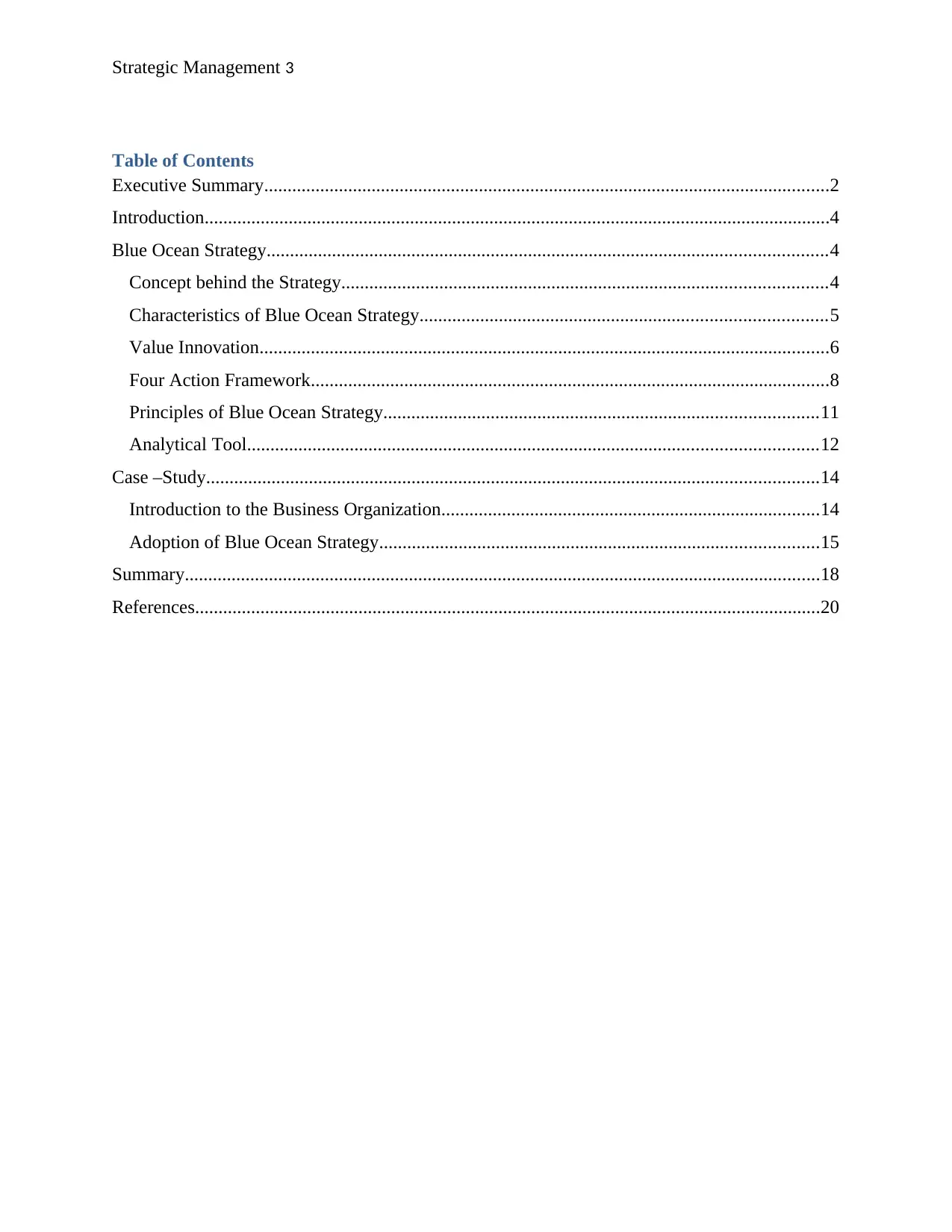
Strategic Management 3
Table of Contents
Executive Summary.........................................................................................................................2
Introduction......................................................................................................................................4
Blue Ocean Strategy........................................................................................................................4
Concept behind the Strategy........................................................................................................4
Characteristics of Blue Ocean Strategy.......................................................................................5
Value Innovation..........................................................................................................................6
Four Action Framework...............................................................................................................8
Principles of Blue Ocean Strategy.............................................................................................11
Analytical Tool..........................................................................................................................12
Case –Study...................................................................................................................................14
Introduction to the Business Organization.................................................................................14
Adoption of Blue Ocean Strategy..............................................................................................15
Summary........................................................................................................................................18
References......................................................................................................................................20
Table of Contents
Executive Summary.........................................................................................................................2
Introduction......................................................................................................................................4
Blue Ocean Strategy........................................................................................................................4
Concept behind the Strategy........................................................................................................4
Characteristics of Blue Ocean Strategy.......................................................................................5
Value Innovation..........................................................................................................................6
Four Action Framework...............................................................................................................8
Principles of Blue Ocean Strategy.............................................................................................11
Analytical Tool..........................................................................................................................12
Case –Study...................................................................................................................................14
Introduction to the Business Organization.................................................................................14
Adoption of Blue Ocean Strategy..............................................................................................15
Summary........................................................................................................................................18
References......................................................................................................................................20
⊘ This is a preview!⊘
Do you want full access?
Subscribe today to unlock all pages.

Trusted by 1+ million students worldwide
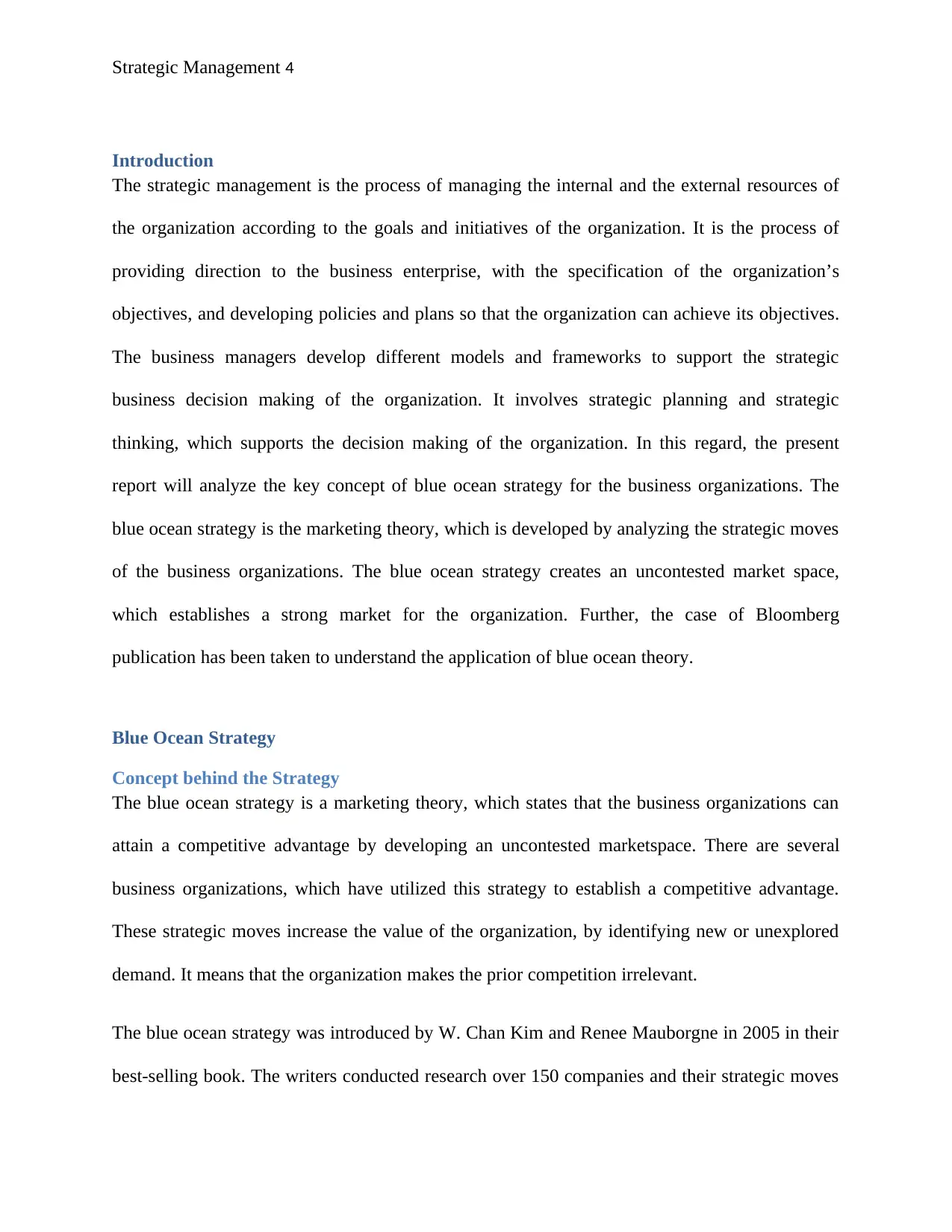
Strategic Management 4
Introduction
The strategic management is the process of managing the internal and the external resources of
the organization according to the goals and initiatives of the organization. It is the process of
providing direction to the business enterprise, with the specification of the organization’s
objectives, and developing policies and plans so that the organization can achieve its objectives.
The business managers develop different models and frameworks to support the strategic
business decision making of the organization. It involves strategic planning and strategic
thinking, which supports the decision making of the organization. In this regard, the present
report will analyze the key concept of blue ocean strategy for the business organizations. The
blue ocean strategy is the marketing theory, which is developed by analyzing the strategic moves
of the business organizations. The blue ocean strategy creates an uncontested market space,
which establishes a strong market for the organization. Further, the case of Bloomberg
publication has been taken to understand the application of blue ocean theory.
Blue Ocean Strategy
Concept behind the Strategy
The blue ocean strategy is a marketing theory, which states that the business organizations can
attain a competitive advantage by developing an uncontested marketspace. There are several
business organizations, which have utilized this strategy to establish a competitive advantage.
These strategic moves increase the value of the organization, by identifying new or unexplored
demand. It means that the organization makes the prior competition irrelevant.
The blue ocean strategy was introduced by W. Chan Kim and Renee Mauborgne in 2005 in their
best-selling book. The writers conducted research over 150 companies and their strategic moves
Introduction
The strategic management is the process of managing the internal and the external resources of
the organization according to the goals and initiatives of the organization. It is the process of
providing direction to the business enterprise, with the specification of the organization’s
objectives, and developing policies and plans so that the organization can achieve its objectives.
The business managers develop different models and frameworks to support the strategic
business decision making of the organization. It involves strategic planning and strategic
thinking, which supports the decision making of the organization. In this regard, the present
report will analyze the key concept of blue ocean strategy for the business organizations. The
blue ocean strategy is the marketing theory, which is developed by analyzing the strategic moves
of the business organizations. The blue ocean strategy creates an uncontested market space,
which establishes a strong market for the organization. Further, the case of Bloomberg
publication has been taken to understand the application of blue ocean theory.
Blue Ocean Strategy
Concept behind the Strategy
The blue ocean strategy is a marketing theory, which states that the business organizations can
attain a competitive advantage by developing an uncontested marketspace. There are several
business organizations, which have utilized this strategy to establish a competitive advantage.
These strategic moves increase the value of the organization, by identifying new or unexplored
demand. It means that the organization makes the prior competition irrelevant.
The blue ocean strategy was introduced by W. Chan Kim and Renee Mauborgne in 2005 in their
best-selling book. The writers conducted research over 150 companies and their strategic moves
Paraphrase This Document
Need a fresh take? Get an instant paraphrase of this document with our AI Paraphraser
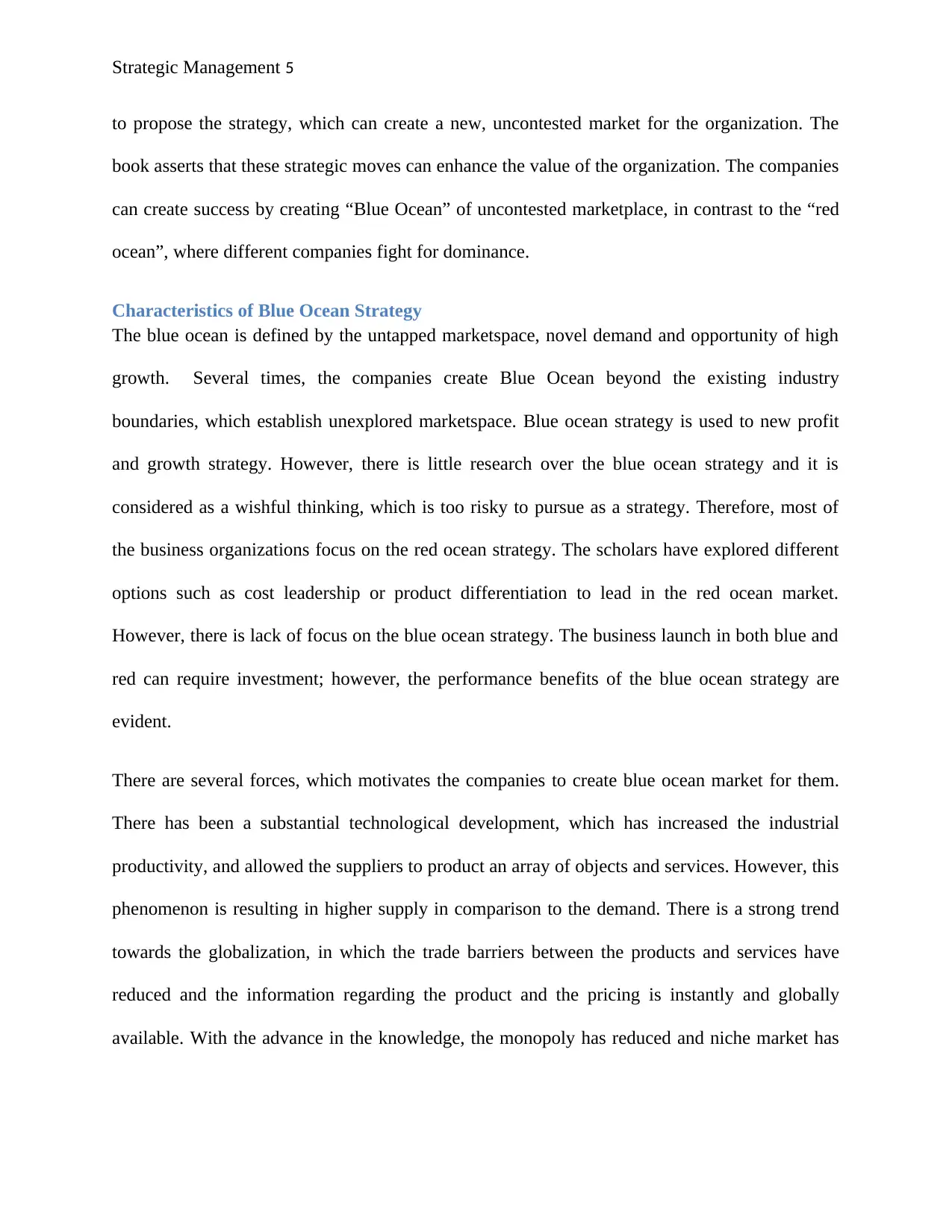
Strategic Management 5
to propose the strategy, which can create a new, uncontested market for the organization. The
book asserts that these strategic moves can enhance the value of the organization. The companies
can create success by creating “Blue Ocean” of uncontested marketplace, in contrast to the “red
ocean”, where different companies fight for dominance.
Characteristics of Blue Ocean Strategy
The blue ocean is defined by the untapped marketspace, novel demand and opportunity of high
growth. Several times, the companies create Blue Ocean beyond the existing industry
boundaries, which establish unexplored marketspace. Blue ocean strategy is used to new profit
and growth strategy. However, there is little research over the blue ocean strategy and it is
considered as a wishful thinking, which is too risky to pursue as a strategy. Therefore, most of
the business organizations focus on the red ocean strategy. The scholars have explored different
options such as cost leadership or product differentiation to lead in the red ocean market.
However, there is lack of focus on the blue ocean strategy. The business launch in both blue and
red can require investment; however, the performance benefits of the blue ocean strategy are
evident.
There are several forces, which motivates the companies to create blue ocean market for them.
There has been a substantial technological development, which has increased the industrial
productivity, and allowed the suppliers to product an array of objects and services. However, this
phenomenon is resulting in higher supply in comparison to the demand. There is a strong trend
towards the globalization, in which the trade barriers between the products and services have
reduced and the information regarding the product and the pricing is instantly and globally
available. With the advance in the knowledge, the monopoly has reduced and niche market has
to propose the strategy, which can create a new, uncontested market for the organization. The
book asserts that these strategic moves can enhance the value of the organization. The companies
can create success by creating “Blue Ocean” of uncontested marketplace, in contrast to the “red
ocean”, where different companies fight for dominance.
Characteristics of Blue Ocean Strategy
The blue ocean is defined by the untapped marketspace, novel demand and opportunity of high
growth. Several times, the companies create Blue Ocean beyond the existing industry
boundaries, which establish unexplored marketspace. Blue ocean strategy is used to new profit
and growth strategy. However, there is little research over the blue ocean strategy and it is
considered as a wishful thinking, which is too risky to pursue as a strategy. Therefore, most of
the business organizations focus on the red ocean strategy. The scholars have explored different
options such as cost leadership or product differentiation to lead in the red ocean market.
However, there is lack of focus on the blue ocean strategy. The business launch in both blue and
red can require investment; however, the performance benefits of the blue ocean strategy are
evident.
There are several forces, which motivates the companies to create blue ocean market for them.
There has been a substantial technological development, which has increased the industrial
productivity, and allowed the suppliers to product an array of objects and services. However, this
phenomenon is resulting in higher supply in comparison to the demand. There is a strong trend
towards the globalization, in which the trade barriers between the products and services have
reduced and the information regarding the product and the pricing is instantly and globally
available. With the advance in the knowledge, the monopoly has reduced and niche market has
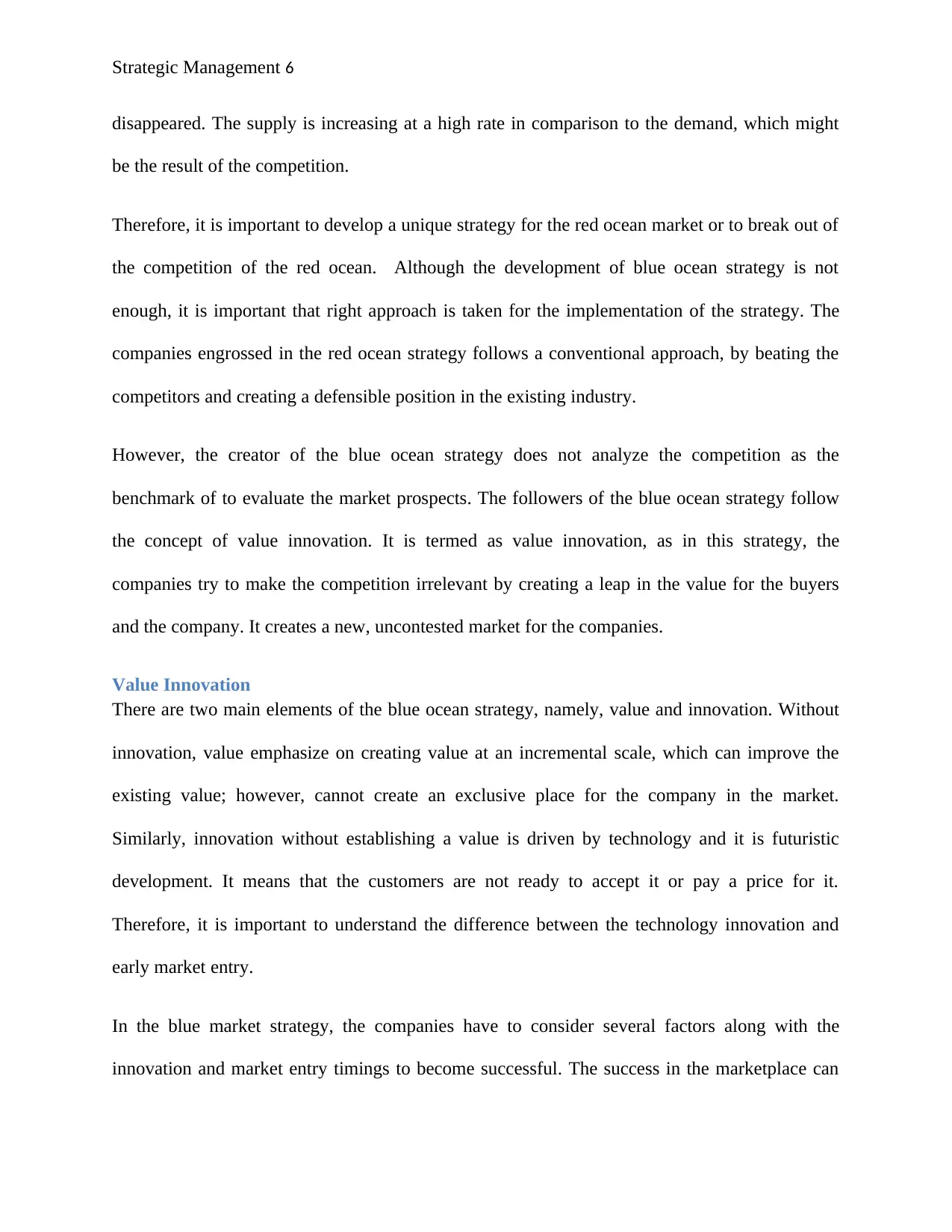
Strategic Management 6
disappeared. The supply is increasing at a high rate in comparison to the demand, which might
be the result of the competition.
Therefore, it is important to develop a unique strategy for the red ocean market or to break out of
the competition of the red ocean. Although the development of blue ocean strategy is not
enough, it is important that right approach is taken for the implementation of the strategy. The
companies engrossed in the red ocean strategy follows a conventional approach, by beating the
competitors and creating a defensible position in the existing industry.
However, the creator of the blue ocean strategy does not analyze the competition as the
benchmark of to evaluate the market prospects. The followers of the blue ocean strategy follow
the concept of value innovation. It is termed as value innovation, as in this strategy, the
companies try to make the competition irrelevant by creating a leap in the value for the buyers
and the company. It creates a new, uncontested market for the companies.
Value Innovation
There are two main elements of the blue ocean strategy, namely, value and innovation. Without
innovation, value emphasize on creating value at an incremental scale, which can improve the
existing value; however, cannot create an exclusive place for the company in the market.
Similarly, innovation without establishing a value is driven by technology and it is futuristic
development. It means that the customers are not ready to accept it or pay a price for it.
Therefore, it is important to understand the difference between the technology innovation and
early market entry.
In the blue market strategy, the companies have to consider several factors along with the
innovation and market entry timings to become successful. The success in the marketplace can
disappeared. The supply is increasing at a high rate in comparison to the demand, which might
be the result of the competition.
Therefore, it is important to develop a unique strategy for the red ocean market or to break out of
the competition of the red ocean. Although the development of blue ocean strategy is not
enough, it is important that right approach is taken for the implementation of the strategy. The
companies engrossed in the red ocean strategy follows a conventional approach, by beating the
competitors and creating a defensible position in the existing industry.
However, the creator of the blue ocean strategy does not analyze the competition as the
benchmark of to evaluate the market prospects. The followers of the blue ocean strategy follow
the concept of value innovation. It is termed as value innovation, as in this strategy, the
companies try to make the competition irrelevant by creating a leap in the value for the buyers
and the company. It creates a new, uncontested market for the companies.
Value Innovation
There are two main elements of the blue ocean strategy, namely, value and innovation. Without
innovation, value emphasize on creating value at an incremental scale, which can improve the
existing value; however, cannot create an exclusive place for the company in the market.
Similarly, innovation without establishing a value is driven by technology and it is futuristic
development. It means that the customers are not ready to accept it or pay a price for it.
Therefore, it is important to understand the difference between the technology innovation and
early market entry.
In the blue market strategy, the companies have to consider several factors along with the
innovation and market entry timings to become successful. The success in the marketplace can
⊘ This is a preview!⊘
Do you want full access?
Subscribe today to unlock all pages.

Trusted by 1+ million students worldwide
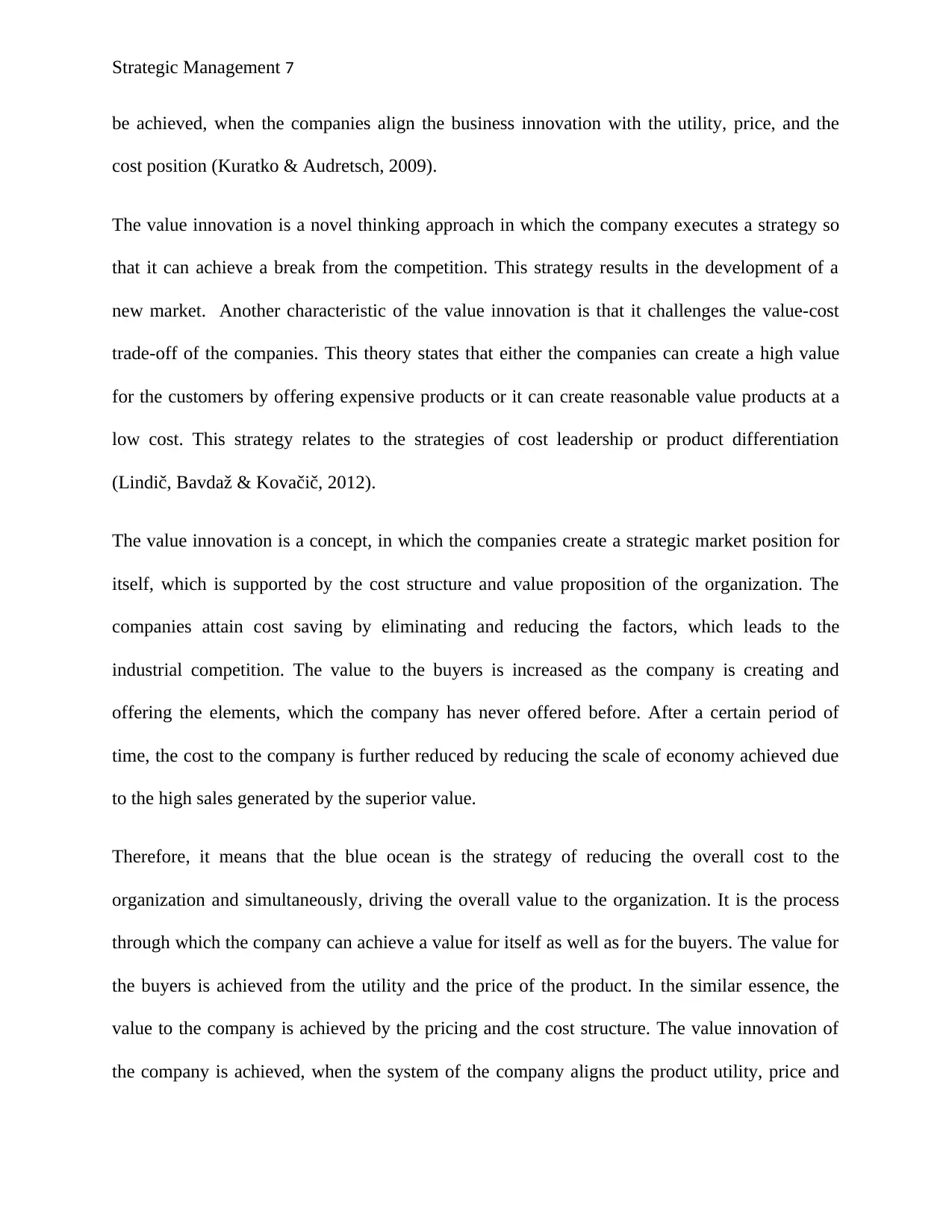
Strategic Management 7
be achieved, when the companies align the business innovation with the utility, price, and the
cost position (Kuratko & Audretsch, 2009).
The value innovation is a novel thinking approach in which the company executes a strategy so
that it can achieve a break from the competition. This strategy results in the development of a
new market. Another characteristic of the value innovation is that it challenges the value-cost
trade-off of the companies. This theory states that either the companies can create a high value
for the customers by offering expensive products or it can create reasonable value products at a
low cost. This strategy relates to the strategies of cost leadership or product differentiation
(Lindič, Bavdaž & Kovačič, 2012).
The value innovation is a concept, in which the companies create a strategic market position for
itself, which is supported by the cost structure and value proposition of the organization. The
companies attain cost saving by eliminating and reducing the factors, which leads to the
industrial competition. The value to the buyers is increased as the company is creating and
offering the elements, which the company has never offered before. After a certain period of
time, the cost to the company is further reduced by reducing the scale of economy achieved due
to the high sales generated by the superior value.
Therefore, it means that the blue ocean is the strategy of reducing the overall cost to the
organization and simultaneously, driving the overall value to the organization. It is the process
through which the company can achieve a value for itself as well as for the buyers. The value for
the buyers is achieved from the utility and the price of the product. In the similar essence, the
value to the company is achieved by the pricing and the cost structure. The value innovation of
the company is achieved, when the system of the company aligns the product utility, price and
be achieved, when the companies align the business innovation with the utility, price, and the
cost position (Kuratko & Audretsch, 2009).
The value innovation is a novel thinking approach in which the company executes a strategy so
that it can achieve a break from the competition. This strategy results in the development of a
new market. Another characteristic of the value innovation is that it challenges the value-cost
trade-off of the companies. This theory states that either the companies can create a high value
for the customers by offering expensive products or it can create reasonable value products at a
low cost. This strategy relates to the strategies of cost leadership or product differentiation
(Lindič, Bavdaž & Kovačič, 2012).
The value innovation is a concept, in which the companies create a strategic market position for
itself, which is supported by the cost structure and value proposition of the organization. The
companies attain cost saving by eliminating and reducing the factors, which leads to the
industrial competition. The value to the buyers is increased as the company is creating and
offering the elements, which the company has never offered before. After a certain period of
time, the cost to the company is further reduced by reducing the scale of economy achieved due
to the high sales generated by the superior value.
Therefore, it means that the blue ocean is the strategy of reducing the overall cost to the
organization and simultaneously, driving the overall value to the organization. It is the process
through which the company can achieve a value for itself as well as for the buyers. The value for
the buyers is achieved from the utility and the price of the product. In the similar essence, the
value to the company is achieved by the pricing and the cost structure. The value innovation of
the company is achieved, when the system of the company aligns the product utility, price and
Paraphrase This Document
Need a fresh take? Get an instant paraphrase of this document with our AI Paraphraser
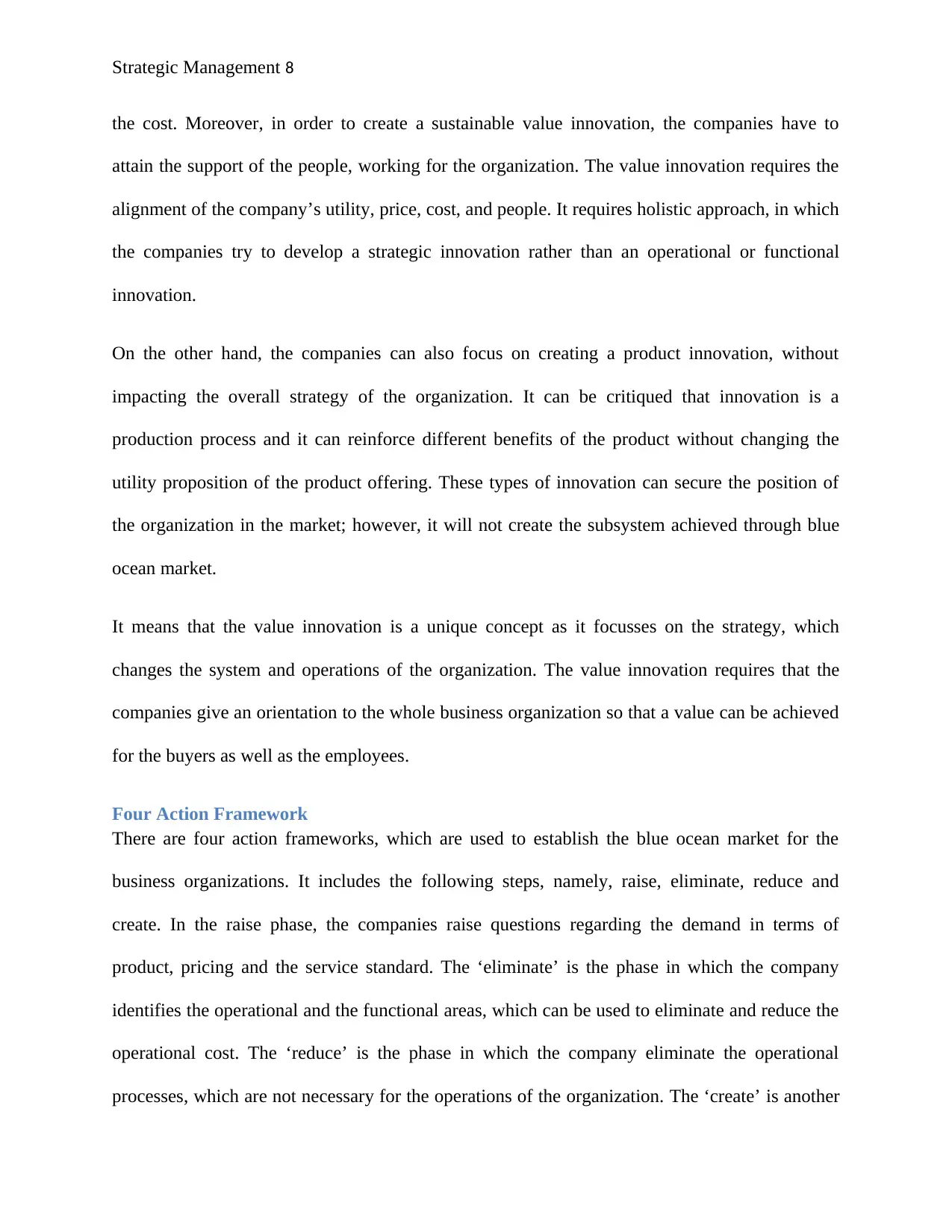
Strategic Management 8
the cost. Moreover, in order to create a sustainable value innovation, the companies have to
attain the support of the people, working for the organization. The value innovation requires the
alignment of the company’s utility, price, cost, and people. It requires holistic approach, in which
the companies try to develop a strategic innovation rather than an operational or functional
innovation.
On the other hand, the companies can also focus on creating a product innovation, without
impacting the overall strategy of the organization. It can be critiqued that innovation is a
production process and it can reinforce different benefits of the product without changing the
utility proposition of the product offering. These types of innovation can secure the position of
the organization in the market; however, it will not create the subsystem achieved through blue
ocean market.
It means that the value innovation is a unique concept as it focusses on the strategy, which
changes the system and operations of the organization. The value innovation requires that the
companies give an orientation to the whole business organization so that a value can be achieved
for the buyers as well as the employees.
Four Action Framework
There are four action frameworks, which are used to establish the blue ocean market for the
business organizations. It includes the following steps, namely, raise, eliminate, reduce and
create. In the raise phase, the companies raise questions regarding the demand in terms of
product, pricing and the service standard. The ‘eliminate’ is the phase in which the company
identifies the operational and the functional areas, which can be used to eliminate and reduce the
operational cost. The ‘reduce’ is the phase in which the company eliminate the operational
processes, which are not necessary for the operations of the organization. The ‘create’ is another
the cost. Moreover, in order to create a sustainable value innovation, the companies have to
attain the support of the people, working for the organization. The value innovation requires the
alignment of the company’s utility, price, cost, and people. It requires holistic approach, in which
the companies try to develop a strategic innovation rather than an operational or functional
innovation.
On the other hand, the companies can also focus on creating a product innovation, without
impacting the overall strategy of the organization. It can be critiqued that innovation is a
production process and it can reinforce different benefits of the product without changing the
utility proposition of the product offering. These types of innovation can secure the position of
the organization in the market; however, it will not create the subsystem achieved through blue
ocean market.
It means that the value innovation is a unique concept as it focusses on the strategy, which
changes the system and operations of the organization. The value innovation requires that the
companies give an orientation to the whole business organization so that a value can be achieved
for the buyers as well as the employees.
Four Action Framework
There are four action frameworks, which are used to establish the blue ocean market for the
business organizations. It includes the following steps, namely, raise, eliminate, reduce and
create. In the raise phase, the companies raise questions regarding the demand in terms of
product, pricing and the service standard. The ‘eliminate’ is the phase in which the company
identifies the operational and the functional areas, which can be used to eliminate and reduce the
operational cost. The ‘reduce’ is the phase in which the company eliminate the operational
processes, which are not necessary for the operations of the organization. The ‘create’ is another
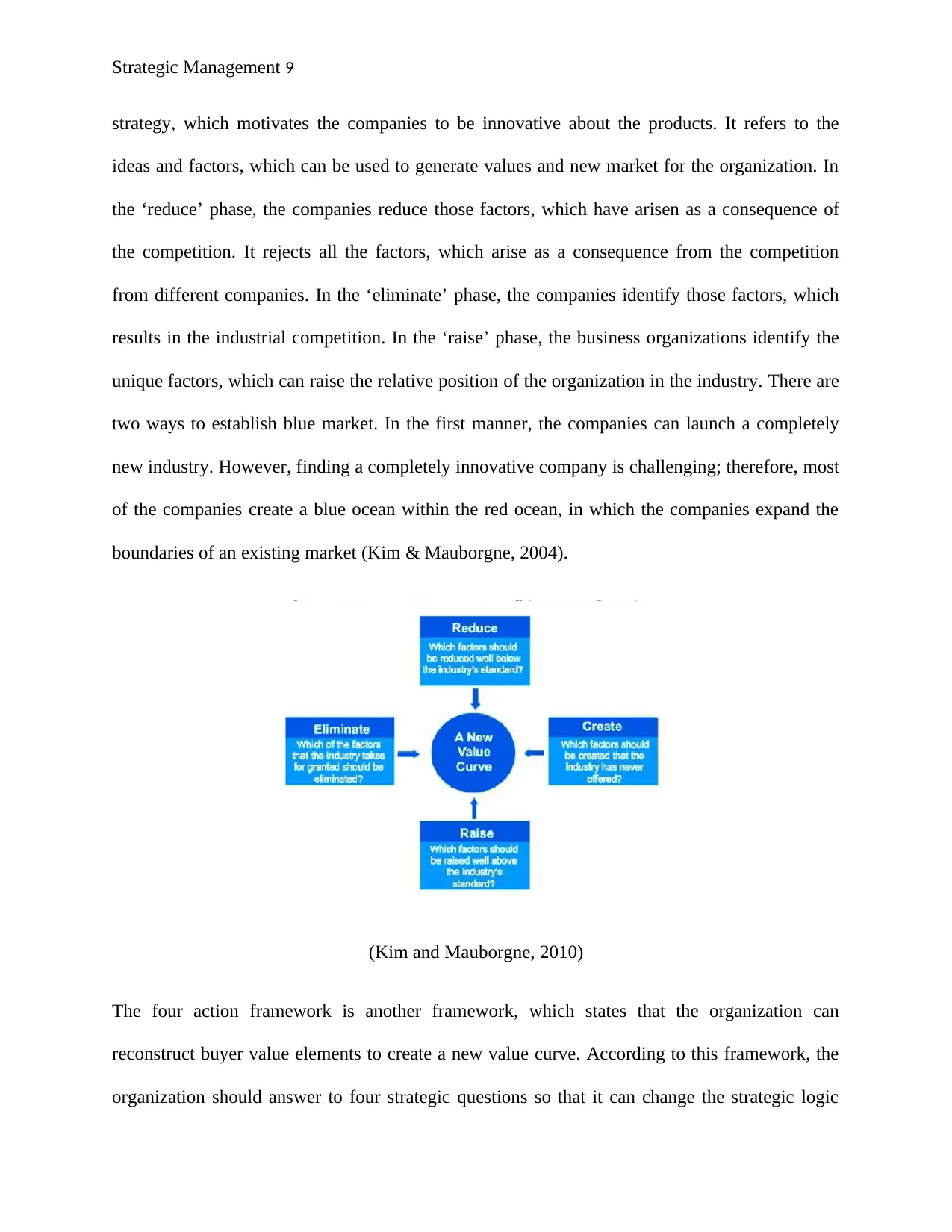
Strategic Management 9
strategy, which motivates the companies to be innovative about the products. It refers to the
ideas and factors, which can be used to generate values and new market for the organization. In
the ‘reduce’ phase, the companies reduce those factors, which have arisen as a consequence of
the competition. It rejects all the factors, which arise as a consequence from the competition
from different companies. In the ‘eliminate’ phase, the companies identify those factors, which
results in the industrial competition. In the ‘raise’ phase, the business organizations identify the
unique factors, which can raise the relative position of the organization in the industry. There are
two ways to establish blue market. In the first manner, the companies can launch a completely
new industry. However, finding a completely innovative company is challenging; therefore, most
of the companies create a blue ocean within the red ocean, in which the companies expand the
boundaries of an existing market (Kim & Mauborgne, 2004).
(Kim and Mauborgne, 2010)
The four action framework is another framework, which states that the organization can
reconstruct buyer value elements to create a new value curve. According to this framework, the
organization should answer to four strategic questions so that it can change the strategic logic
strategy, which motivates the companies to be innovative about the products. It refers to the
ideas and factors, which can be used to generate values and new market for the organization. In
the ‘reduce’ phase, the companies reduce those factors, which have arisen as a consequence of
the competition. It rejects all the factors, which arise as a consequence from the competition
from different companies. In the ‘eliminate’ phase, the companies identify those factors, which
results in the industrial competition. In the ‘raise’ phase, the business organizations identify the
unique factors, which can raise the relative position of the organization in the industry. There are
two ways to establish blue market. In the first manner, the companies can launch a completely
new industry. However, finding a completely innovative company is challenging; therefore, most
of the companies create a blue ocean within the red ocean, in which the companies expand the
boundaries of an existing market (Kim & Mauborgne, 2004).
(Kim and Mauborgne, 2010)
The four action framework is another framework, which states that the organization can
reconstruct buyer value elements to create a new value curve. According to this framework, the
organization should answer to four strategic questions so that it can change the strategic logic
⊘ This is a preview!⊘
Do you want full access?
Subscribe today to unlock all pages.

Trusted by 1+ million students worldwide
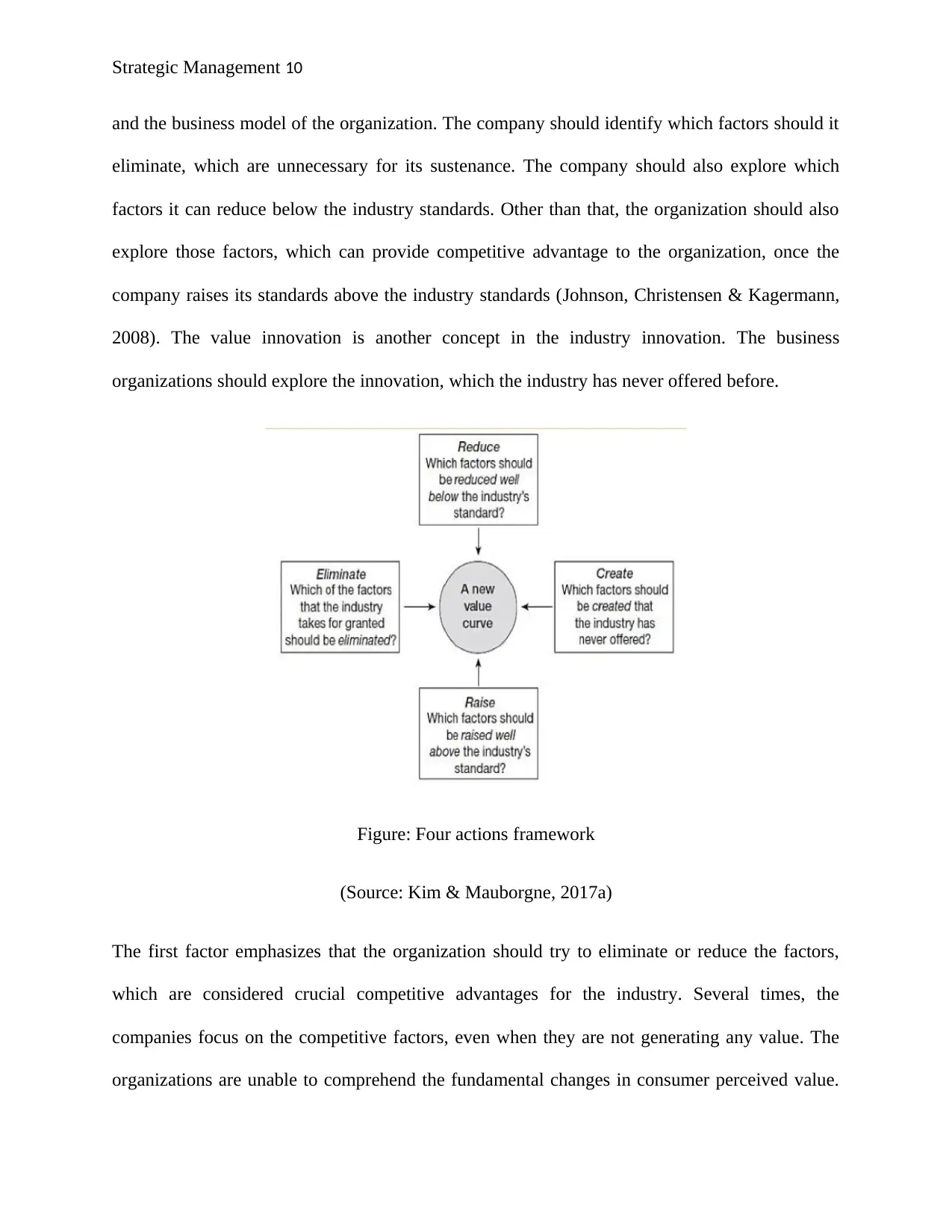
Strategic Management 10
and the business model of the organization. The company should identify which factors should it
eliminate, which are unnecessary for its sustenance. The company should also explore which
factors it can reduce below the industry standards. Other than that, the organization should also
explore those factors, which can provide competitive advantage to the organization, once the
company raises its standards above the industry standards (Johnson, Christensen & Kagermann,
2008). The value innovation is another concept in the industry innovation. The business
organizations should explore the innovation, which the industry has never offered before.
Figure: Four actions framework
(Source: Kim & Mauborgne, 2017a)
The first factor emphasizes that the organization should try to eliminate or reduce the factors,
which are considered crucial competitive advantages for the industry. Several times, the
companies focus on the competitive factors, even when they are not generating any value. The
organizations are unable to comprehend the fundamental changes in consumer perceived value.
and the business model of the organization. The company should identify which factors should it
eliminate, which are unnecessary for its sustenance. The company should also explore which
factors it can reduce below the industry standards. Other than that, the organization should also
explore those factors, which can provide competitive advantage to the organization, once the
company raises its standards above the industry standards (Johnson, Christensen & Kagermann,
2008). The value innovation is another concept in the industry innovation. The business
organizations should explore the innovation, which the industry has never offered before.
Figure: Four actions framework
(Source: Kim & Mauborgne, 2017a)
The first factor emphasizes that the organization should try to eliminate or reduce the factors,
which are considered crucial competitive advantages for the industry. Several times, the
companies focus on the competitive factors, even when they are not generating any value. The
organizations are unable to comprehend the fundamental changes in consumer perceived value.
Paraphrase This Document
Need a fresh take? Get an instant paraphrase of this document with our AI Paraphraser
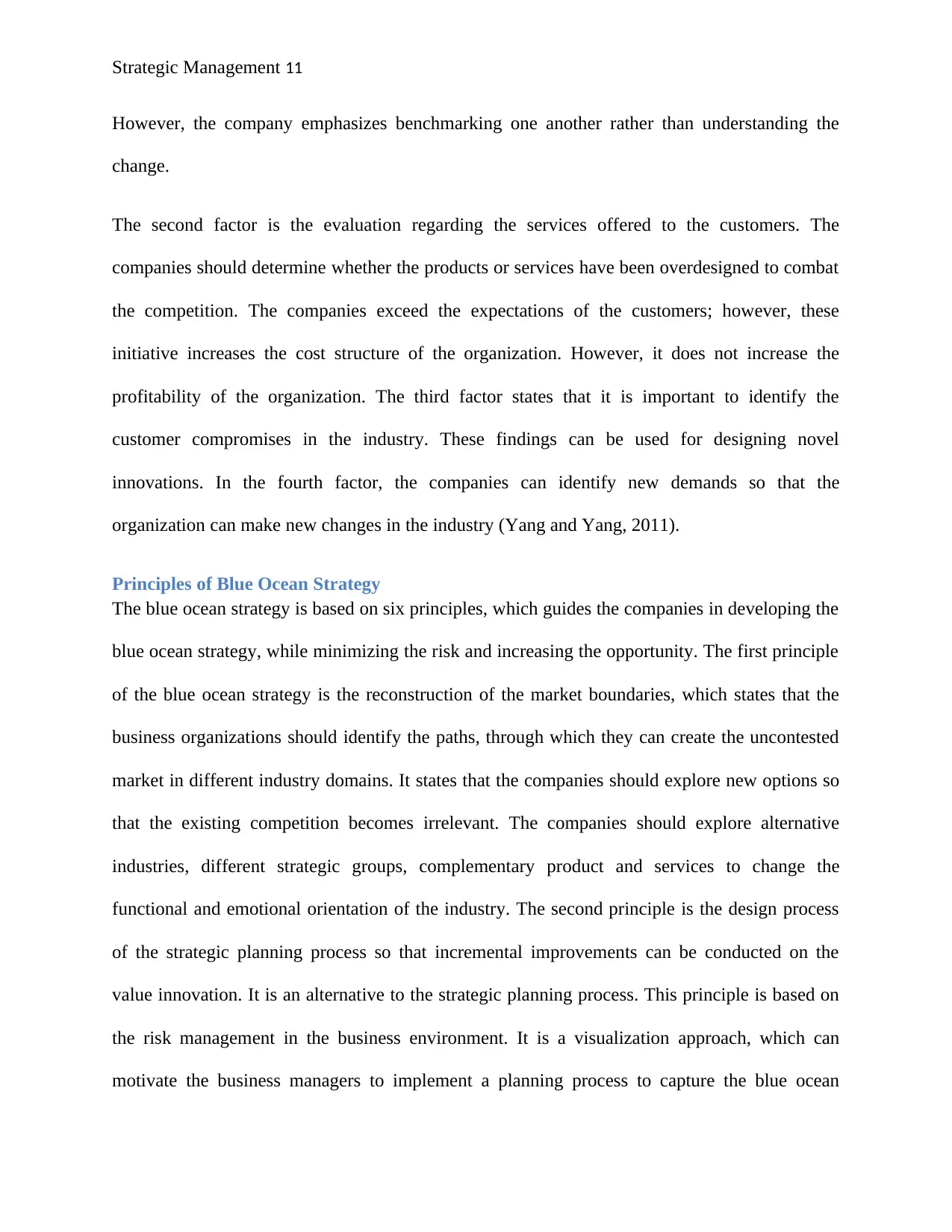
Strategic Management 11
However, the company emphasizes benchmarking one another rather than understanding the
change.
The second factor is the evaluation regarding the services offered to the customers. The
companies should determine whether the products or services have been overdesigned to combat
the competition. The companies exceed the expectations of the customers; however, these
initiative increases the cost structure of the organization. However, it does not increase the
profitability of the organization. The third factor states that it is important to identify the
customer compromises in the industry. These findings can be used for designing novel
innovations. In the fourth factor, the companies can identify new demands so that the
organization can make new changes in the industry (Yang and Yang, 2011).
Principles of Blue Ocean Strategy
The blue ocean strategy is based on six principles, which guides the companies in developing the
blue ocean strategy, while minimizing the risk and increasing the opportunity. The first principle
of the blue ocean strategy is the reconstruction of the market boundaries, which states that the
business organizations should identify the paths, through which they can create the uncontested
market in different industry domains. It states that the companies should explore new options so
that the existing competition becomes irrelevant. The companies should explore alternative
industries, different strategic groups, complementary product and services to change the
functional and emotional orientation of the industry. The second principle is the design process
of the strategic planning process so that incremental improvements can be conducted on the
value innovation. It is an alternative to the strategic planning process. This principle is based on
the risk management in the business environment. It is a visualization approach, which can
motivate the business managers to implement a planning process to capture the blue ocean
However, the company emphasizes benchmarking one another rather than understanding the
change.
The second factor is the evaluation regarding the services offered to the customers. The
companies should determine whether the products or services have been overdesigned to combat
the competition. The companies exceed the expectations of the customers; however, these
initiative increases the cost structure of the organization. However, it does not increase the
profitability of the organization. The third factor states that it is important to identify the
customer compromises in the industry. These findings can be used for designing novel
innovations. In the fourth factor, the companies can identify new demands so that the
organization can make new changes in the industry (Yang and Yang, 2011).
Principles of Blue Ocean Strategy
The blue ocean strategy is based on six principles, which guides the companies in developing the
blue ocean strategy, while minimizing the risk and increasing the opportunity. The first principle
of the blue ocean strategy is the reconstruction of the market boundaries, which states that the
business organizations should identify the paths, through which they can create the uncontested
market in different industry domains. It states that the companies should explore new options so
that the existing competition becomes irrelevant. The companies should explore alternative
industries, different strategic groups, complementary product and services to change the
functional and emotional orientation of the industry. The second principle is the design process
of the strategic planning process so that incremental improvements can be conducted on the
value innovation. It is an alternative to the strategic planning process. This principle is based on
the risk management in the business environment. It is a visualization approach, which can
motivate the business managers to implement a planning process to capture the blue ocean
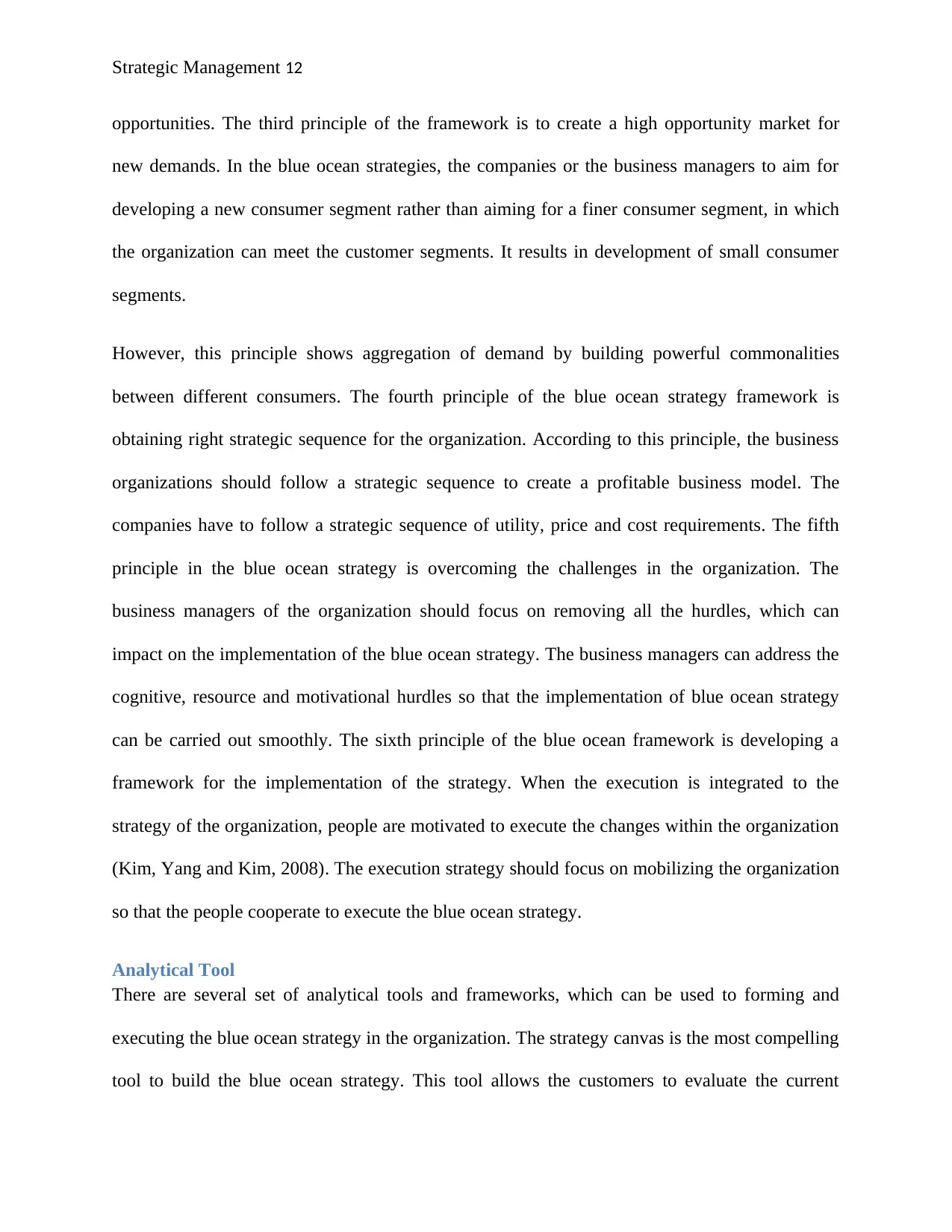
Strategic Management 12
opportunities. The third principle of the framework is to create a high opportunity market for
new demands. In the blue ocean strategies, the companies or the business managers to aim for
developing a new consumer segment rather than aiming for a finer consumer segment, in which
the organization can meet the customer segments. It results in development of small consumer
segments.
However, this principle shows aggregation of demand by building powerful commonalities
between different consumers. The fourth principle of the blue ocean strategy framework is
obtaining right strategic sequence for the organization. According to this principle, the business
organizations should follow a strategic sequence to create a profitable business model. The
companies have to follow a strategic sequence of utility, price and cost requirements. The fifth
principle in the blue ocean strategy is overcoming the challenges in the organization. The
business managers of the organization should focus on removing all the hurdles, which can
impact on the implementation of the blue ocean strategy. The business managers can address the
cognitive, resource and motivational hurdles so that the implementation of blue ocean strategy
can be carried out smoothly. The sixth principle of the blue ocean framework is developing a
framework for the implementation of the strategy. When the execution is integrated to the
strategy of the organization, people are motivated to execute the changes within the organization
(Kim, Yang and Kim, 2008). The execution strategy should focus on mobilizing the organization
so that the people cooperate to execute the blue ocean strategy.
Analytical Tool
There are several set of analytical tools and frameworks, which can be used to forming and
executing the blue ocean strategy in the organization. The strategy canvas is the most compelling
tool to build the blue ocean strategy. This tool allows the customers to evaluate the current
opportunities. The third principle of the framework is to create a high opportunity market for
new demands. In the blue ocean strategies, the companies or the business managers to aim for
developing a new consumer segment rather than aiming for a finer consumer segment, in which
the organization can meet the customer segments. It results in development of small consumer
segments.
However, this principle shows aggregation of demand by building powerful commonalities
between different consumers. The fourth principle of the blue ocean strategy framework is
obtaining right strategic sequence for the organization. According to this principle, the business
organizations should follow a strategic sequence to create a profitable business model. The
companies have to follow a strategic sequence of utility, price and cost requirements. The fifth
principle in the blue ocean strategy is overcoming the challenges in the organization. The
business managers of the organization should focus on removing all the hurdles, which can
impact on the implementation of the blue ocean strategy. The business managers can address the
cognitive, resource and motivational hurdles so that the implementation of blue ocean strategy
can be carried out smoothly. The sixth principle of the blue ocean framework is developing a
framework for the implementation of the strategy. When the execution is integrated to the
strategy of the organization, people are motivated to execute the changes within the organization
(Kim, Yang and Kim, 2008). The execution strategy should focus on mobilizing the organization
so that the people cooperate to execute the blue ocean strategy.
Analytical Tool
There are several set of analytical tools and frameworks, which can be used to forming and
executing the blue ocean strategy in the organization. The strategy canvas is the most compelling
tool to build the blue ocean strategy. This tool allows the customers to evaluate the current
⊘ This is a preview!⊘
Do you want full access?
Subscribe today to unlock all pages.

Trusted by 1+ million students worldwide
1 out of 22
Related Documents
Your All-in-One AI-Powered Toolkit for Academic Success.
+13062052269
info@desklib.com
Available 24*7 on WhatsApp / Email
![[object Object]](/_next/static/media/star-bottom.7253800d.svg)
Unlock your academic potential
Copyright © 2020–2025 A2Z Services. All Rights Reserved. Developed and managed by ZUCOL.



